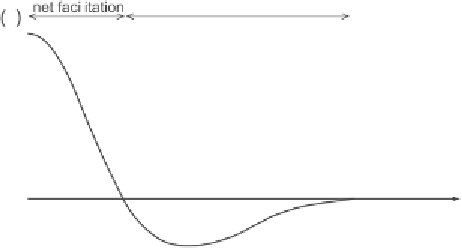Environmental Engineering Reference
In-Depth Information
ω
Z
′
−
r
r
Z
Figure B.3. Typical kernel that exhibits local activation-long-range inhibition.
Fig.
B.3
can be obtained for example as the difference between two exponential
functions of the form
=
b
1
exp
2
−
b
2
exp
2
z
q
1
z
q
2
ω
(
z
)
−
−
,
(B.13)
where 0
<
q
1
<
q
2
and
b
1
and
b
2
are two coefficients expressing the relative im-
portance of the facilitation and competition components of the kernel (see also
Chapter 6).
The dynamics expressed by Eq. (
B.12
) may lead to pattern formation through
mechanisms that resemble those of Turing's instability. In fact, patterns emerge as a
result of the spatial interactions, which destabilize the uniform stable state
φ
0
of the
local dynamics. To study the stability of the state
φ
=
φ
0
with respect to infinitesimal
perturbations, we linearize Eq. (
B.12
) around the steady state
φ
=
φ
0
. Indicating by
ˆ
φ
=
φ
−
φ
0
the amplitude of the (“small”) perturbation, we obtain
∂
ˆ
φ
∂
ˆ
)
ˆ
f
(
r
−
(
r
,
t
)d
r
,
=
φ
φ
0
)
+
ω
(
|
r
|
φ
(B.14)
t
where
f
(
φ
=
φ
0
.
Solutions of Eq. (
B.14
) can be expressed in the form of integral sums of the
harmonics
ˆ
φ
0
) is the derivative of the function
f
(
φ
), calculated for
φ
(
r
,
t
)
∝
exp[
γ
t
+
i
k
·
r
], where each harmonic is a solution of (
B.14
),
k
=
(
k
x
,
k
y
) is the wave-number vector, and the growth factor
γ
is an eigenvalue of
r
−
Eq. (
B.14
). Substituting this solution into Eq. (
B.14
), setting
z
, and cancel-
ing out the exponential function, we obtain the dispersion relation, that is, the relation
between
k
and
=|
r
|
γ
in solutions of (
B.12
) obtained as small perturbations of the state
φ
=
φ
0
:
f
(
f
(
γ
(
k
)
=
φ
0
)
+
ω
(
z
)exp[
i
k
·
z
]d
z
=
φ
0
)
+
W
(
k
)
,
(B.15)








Search WWH ::

Custom Search